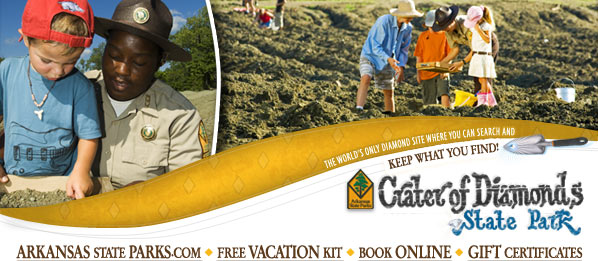
|
The Fine Art of Finding Diamonds By Margi Jenks The single most often asked question by our visitors is “What’s the best place for me to find a diamond?” Our 37.5 acre field is a lot of area and can look pretty intimidating, especially for our first-time visitors. The question has several answers. When I am in a teasing mood and someone asks me that question while we are in the Diamond Discovery Center, I can’t resist saying “out there” and pointing out to the diamond search area.
Our second typical answer is more serious: “Anywhere out on the search area is as good as anywhere else”. That answer is true because the Crater really is the crater of a volcano. When our visitors walk out to the end of the sidewalk and step off into the search area, they are walking into the crater of a volcano that erupted approximately 100 million years ago. The diamonds were already crystals mixed into the lava when the eruption began. It was a very explosive eruption, fueled by huge amounts of gas mixed in with the lava. When the lava hit the surface the gas helped to change the lava into tiny bits of ash. The explosion was so big that it blew a six-hundred-foot-deep crater and blasted out an ash cloud that may have been 3 or 4 times the ash cloud erupted by Mt. St. Helens in 1981. As the initial eruption slowed down and didn’t continue to pump energy into the ash cloud, the cloud quickly collapsed. The collapse filled the crater with the ash and lava bits, but also with the diamonds. This method of making the ash and diamond deposits that fill the crater means that the diamonds are randomly scattered throughout the ash. When the ash deposits are exposed to the surface, they weather first into clay and then into dirt. This weathering concentrates the diamonds in the soil/dirt horizon above the crater-filling volcanic ash and lava.
Our third typical answer is “Look for the areas of sand and gravel.” This answer is also correct because diamonds are heavier in weight than the ash fragments, clay, and dirt. When we have a rain after we have plowed the field, the dirt and clay exposed on the tops of the furrows is washed away by the rain, leaving the heavier and larger pieces, like the diamonds and gravel, covering the tops of the furrows. This process is the reason that most of our larger diamonds are found by the visitors that are carefully searching the tops of the furrows. However, when it rains hard, the runoff also acts as a natural sluice and can wash the smaller diamonds off of the furrows and into the ditches between them. They are carried along by the water in the ditches until the stream reaches a part of the ditch that is not as steep. At that point the stream no longer has the energy to continue to carry the heavier/larger pieces. They become mini-sand/gravel bars in the ditches between the furrows. When our visitors dry-sift or wet sluice the material from those mini-gravel bars, they are working with material that has already been concentrated by the action of the rain, and therefore is more likely to contain a diamond. Finally, if the search area really did have one particular area that yields the most diamonds, then we would have a 2 acre search area, rather than our 37.5 acre field. We hope that if our visitors follow these diamond-finding tips, they will increase their chances of taking home a diamond.
Search area last plowed: October 20, 2009, Total diamonds so far in 2009 - 860
Diamond finds for November 16th to November 22nd (100 pts. = 1 carat): November 16 - Kenny and Melissa Oliver, Rosston, AR, 2 pt. white November 17 - Chad Johnson, Murfreesboro, AR, 40 pt. white November 18 - Eric Young, Eureka Springs, AR, 3 pt. white November 19 - Leslie Turner, Ft. Worth, TX, 2 pt. white; Tracie Ferrell, Bella Vista, AR, 4 pt. white November 21 - Peggy Qualls, Avinger, TX, 1.13 carat white; Kenneth Shoemaker, Murfreesboro, AR, 5 pt. yellow November 22 - Susan Spain, Hickory Creek, TX, 3 pt. white |

209 State Park Road
Murfreesboro, AR 71958
Email: craterofdiamonds@arkansas.com
Phone: (870) 285-3113
You are currently subscribed to the Crater of Diamonds State Park enewsletter as: &*TO;.
To unsubscribe, go to http://diamondsstatepark.xyz/newsletter/ and click the "Unsubscribe" button.
